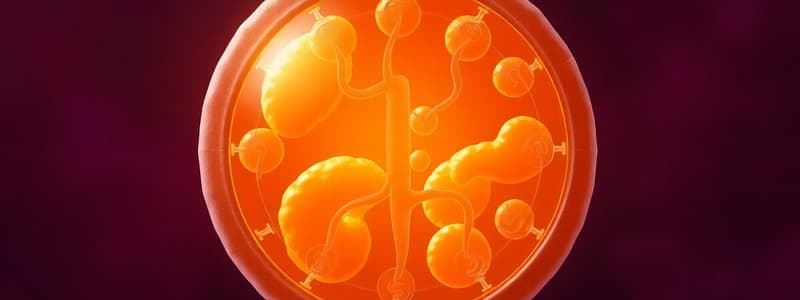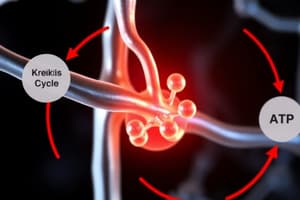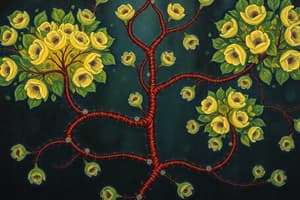Podcast
Questions and Answers
What is the net gain of ATP produced during glycolysis?
What is the net gain of ATP produced during glycolysis?
- 3
- 4
- 2 (correct)
- 5
Which of the following is a product of the citric acid cycle?
Which of the following is a product of the citric acid cycle?
- Glucose
- ATP
- Pyruvate
- NADH (correct)
How many molecules of ATP are produced per molecule of glucose during oxidative phosphorylation?
How many molecules of ATP are produced per molecule of glucose during oxidative phosphorylation?
- 38 (correct)
- 40
- 32
- 2
What is the role of FAD in the citric acid cycle?
What is the role of FAD in the citric acid cycle?
Which of the following steps in the citric acid cycle involves the addition of a water molecule?
Which of the following steps in the citric acid cycle involves the addition of a water molecule?
What is the other name for the Krebs cycle?
What is the other name for the Krebs cycle?
What is the main purpose of the Krebs cycle?
What is the main purpose of the Krebs cycle?
What molecule combines with oxaloacetate to initiate the Krebs cycle?
What molecule combines with oxaloacetate to initiate the Krebs cycle?
How many ATP molecules are produced directly in the Krebs cycle per glucose molecule?
How many ATP molecules are produced directly in the Krebs cycle per glucose molecule?
What is the primary role of NADH and FADH2 in the Krebs cycle?
What is the primary role of NADH and FADH2 in the Krebs cycle?
Which process is NOT a component of the Krebs cycle?
Which process is NOT a component of the Krebs cycle?
What is the name of the process that converts pyruvate to acetyl-CoA?
What is the name of the process that converts pyruvate to acetyl-CoA?
What is the significance of the Krebs cycle in anabolism?
What is the significance of the Krebs cycle in anabolism?
What is the net gain of ATP produced during the Krebs cycle per glucose molecule?
What is the net gain of ATP produced during the Krebs cycle per glucose molecule?
How many NADH molecules are produced altogether per glucose molecule in the Krebs cycle?
How many NADH molecules are produced altogether per glucose molecule in the Krebs cycle?
What happens to Isocitrate during its conversion to α-Ketoglutarate?
What happens to Isocitrate during its conversion to α-Ketoglutarate?
Which enzyme is responsible for the conversion of Isocitrate to α-Ketoglutarate?
Which enzyme is responsible for the conversion of Isocitrate to α-Ketoglutarate?
What is produced as a result of the oxidation of Isocitrate?
What is produced as a result of the oxidation of Isocitrate?
During the conversion of α-Ketoglutarate, what occurs after another CO2 molecule is lost?
During the conversion of α-Ketoglutarate, what occurs after another CO2 molecule is lost?
What type of reaction occurs when Citric acid loses its CH2 and CO2 molecules?
What type of reaction occurs when Citric acid loses its CH2 and CO2 molecules?
What is the initial product formed from citrate during the conversion process?
What is the initial product formed from citrate during the conversion process?
Which enzyme is responsible for converting citrate to isocitrate?
Which enzyme is responsible for converting citrate to isocitrate?
What process occurs when proteins are broken down into amino acids during severe starvation?
What process occurs when proteins are broken down into amino acids during severe starvation?
What happens to isocitrate during its conversion in the citric acid cycle?
What happens to isocitrate during its conversion in the citric acid cycle?
Which compound is formed after isocitrate loses a CO2 molecule?
Which compound is formed after isocitrate loses a CO2 molecule?
Which type of organism can perform both aerobic respiration and anaerobic respiration?
Which type of organism can perform both aerobic respiration and anaerobic respiration?
What is the end product of alcoholic fermentation carried out by yeast?
What is the end product of alcoholic fermentation carried out by yeast?
During the conversion of isocitrate, what does NAD+ get reduced to?
During the conversion of isocitrate, what does NAD+ get reduced to?
What role does aconitase play in the citric acid cycle?
What role does aconitase play in the citric acid cycle?
During strenuous exercise, what causes muscle cells to switch from aerobic respiration to lactic acid fermentation?
During strenuous exercise, what causes muscle cells to switch from aerobic respiration to lactic acid fermentation?
What accumulates in muscles during lactic acid fermentation?
What accumulates in muscles during lactic acid fermentation?
What type of reaction occurs when citrate is converted to isocitrate?
What type of reaction occurs when citrate is converted to isocitrate?
What is the significance of the CO2 molecule lost during the conversion of isocitrate?
What is the significance of the CO2 molecule lost during the conversion of isocitrate?
What is the role of NADH in alcoholic fermentation?
What is the role of NADH in alcoholic fermentation?
What is the primary function of lactate in muscle cells during exercise?
What is the primary function of lactate in muscle cells during exercise?
Where is excess lactate transported after accumulation in muscles?
Where is excess lactate transported after accumulation in muscles?
What is the total number of ATP produced from 10 NADH and 2 FADH2 during aerobic respiration?
What is the total number of ATP produced from 10 NADH and 2 FADH2 during aerobic respiration?
Which factor affects the variation in ATP production in different cells?
Which factor affects the variation in ATP production in different cells?
What is the final equation representing the overall reaction of aerobic respiration?
What is the final equation representing the overall reaction of aerobic respiration?
How many ATP molecules are generated from 1 FADH2 during aerobic respiration?
How many ATP molecules are generated from 1 FADH2 during aerobic respiration?
In brain cells, how many ATP result from NADH during glycolysis?
In brain cells, how many ATP result from NADH during glycolysis?
What is the amount of ATP produced during glycolysis?
What is the amount of ATP produced during glycolysis?
What is produced by the oxidation of fats in respiration?
What is produced by the oxidation of fats in respiration?
During oxidative phosphorylation, how much ATP is produced on average per glucose molecule?
During oxidative phosphorylation, how much ATP is produced on average per glucose molecule?
Which substrate is primarily oxidized for energy during aerobic respiration?
Which substrate is primarily oxidized for energy during aerobic respiration?
Which of the following statements about ATP yield in aerobic respiration is false?
Which of the following statements about ATP yield in aerobic respiration is false?
Flashcards
Citric Acid Cycle
Citric Acid Cycle
A key metabolic pathway involved in cellular respiration, converting acetyl CoA into energy.
Acetyl CoA
Acetyl CoA
A molecule that enters the citric acid cycle, derived from carbohydrates and fats.
NADH
NADH
An electron carrier produced during glycolysis and the citric acid cycle, important for ATP production.
ATP Production
ATP Production
Signup and view all the flashcards
Oxidative Phosphorylation
Oxidative Phosphorylation
Signup and view all the flashcards
Deamination
Deamination
Signup and view all the flashcards
Facultative anaerobes
Facultative anaerobes
Signup and view all the flashcards
Obligate anaerobes
Obligate anaerobes
Signup and view all the flashcards
Alcoholic fermentation
Alcoholic fermentation
Signup and view all the flashcards
Lactic acid fermentation
Lactic acid fermentation
Signup and view all the flashcards
Pyruvate
Pyruvate
Signup and view all the flashcards
Liver role in lactate
Liver role in lactate
Signup and view all the flashcards
NAD+ regeneration
NAD+ regeneration
Signup and view all the flashcards
Citrate
Citrate
Signup and view all the flashcards
Isocitrate
Isocitrate
Signup and view all the flashcards
Aconitase
Aconitase
Signup and view all the flashcards
α-Ketoglutarate
α-Ketoglutarate
Signup and view all the flashcards
CO2 loss
CO2 loss
Signup and view all the flashcards
Oxidation of Isocitrate
Oxidation of Isocitrate
Signup and view all the flashcards
Isocitrate Dehydrogenase
Isocitrate Dehydrogenase
Signup and view all the flashcards
Cellular Respiration
Cellular Respiration
Signup and view all the flashcards
Glycolysis
Glycolysis
Signup and view all the flashcards
Krebs Cycle (Citric Acid Cycle)
Krebs Cycle (Citric Acid Cycle)
Signup and view all the flashcards
Products of Krebs Cycle
Products of Krebs Cycle
Signup and view all the flashcards
Electron Transport Chain
Electron Transport Chain
Signup and view all the flashcards
Decarboxylation
Decarboxylation
Signup and view all the flashcards
Anabolism
Anabolism
Signup and view all the flashcards
Fermentation
Fermentation
Signup and view all the flashcards
NADH ATP yield
NADH ATP yield
Signup and view all the flashcards
FADH2 ATP yield
FADH2 ATP yield
Signup and view all the flashcards
ATP total from glycolysis
ATP total from glycolysis
Signup and view all the flashcards
ATP total from Krebs cycle
ATP total from Krebs cycle
Signup and view all the flashcards
Total ATP from ETC
Total ATP from ETC
Signup and view all the flashcards
Overall ATP yield
Overall ATP yield
Signup and view all the flashcards
Equation of aerobic respiration
Equation of aerobic respiration
Signup and view all the flashcards
Effect of shuttle systems
Effect of shuttle systems
Signup and view all the flashcards
ATPs from brain cells
ATPs from brain cells
Signup and view all the flashcards
ATPs from liver and heart cells
ATPs from liver and heart cells
Signup and view all the flashcards




